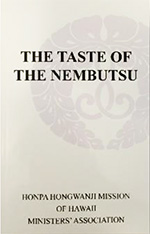
A message from Rev. Tomo Hojo which appears in the book, “The Taste of the Nembutsu,” published in 2016 by the HHMH State Ministers’ Association. The book is a collection of dharma messages by each of the active ministers.
To extend the reach of the dharma within these messages, we will publish one per week on our website.
Cooking and the Nembutsu
Rev. Tomo Hojo
We have many events every month in Hawaii. We get together often with family and friends. When we get together we enjoy food with them. Therefore, I’d like to talk about cooking and the Nembutsu.
Do you like to cook? I’m not a good cook but love to eat. I have many favorite foods including pipikaula, haupia, soba, poke, nabe and so on. Ishihara Market and Big Save is my second kitchen now.
What kinds of food do you like? I like nabe, especially in the winter. Nabe is a style of Japanese hot pot cooking with lots of vegetables and meat in a yummy broth.
Have you ever eaten nabe before? I ate nabe; actually it was chicken hekka.
A temple family invited me over for dinner. I really enjoyed the dinner and conversed with them. They served tasty foods and one of them was chicken hekka.
When I was eating chicken hekka, I realized that an interesting point of nabe is that we eat it with family or friends. We sit down around the nabe and talk story while eating. If I eat nabe alone I feel lonely.
Another point of nabe is that I can use any kind of meat or vegetable. I can use beef, chicken, pork, fish, cabbage, mushroom, tofu, et cetera.
These foods mixed together in the nabe make a wonderful taste. No one argues about wanting meat or fish or vegetable.
I think nabe is related to the Nembutsu teachings.
Amida Buddha’s primal vow never leaves out anyone and doesn’t discriminate the young or old, smart or foolish, good looking or unattractive, rich or poor, good or bad person.
All you need to be is a person who trusts Amida Buddha’s primal vow and say the Nembutsu. All of this along with Amida Buddha’s compassion becomes a wonderful taste.
When I think about that I remember a poem written by Mrs. Misuzu Kaneko. It’s titled, “Me, A Songbird, And A Bell.”
Spread my arms though I may I’ll never fly up in the sky.
Songbirds fly but they can’t run Fast on the ground like I do.
Shake myself though I may No pretty sound comes out.
Bells jingle but they don’t know Lot of songs like I do.
Bell, songbird, and me All different, all just right.
(Something Nice: Page 11)
Don’t you think it is a wonderful poem?
I like her poems. She came to the temple faithfully with her grandmother and listened to Amida Buddha’s teaching. Thus she was able to write thoughtful and beautiful poems.
If you listen to the Dharma you are able to realize “all are different, all are just right.”
Shakyamuni Buddha said in the Amida Sutra,
In the ponds are lotuses as large as chariot-wheels – the blue ones radiating a blue light, the yellow a yellow light, the red a red light and the white a white light. They are marvelous and beautiful, fragrant and pure.
(The Three Pure Land Sutras: Page 354)
It means all are different, all are just right. If we can accept the differences, this would be a world of perfect peace.
But sometimes we may want to be different from what we really are. We may try to shine blue, even if we are red or shine yellow from green. That makes us suffer and gives us problems.
Amida Buddha knows our minds and is saying that you don’t need to shine a different color and you don’t need to compare yourself with other people. You can shine your own color, just as you are.
Mrs. Misuzu Kaneko grew up with this teaching, thus she was able to write this wonderful poem.
Let us keep listening to Amida Buddha’s teachings. All people are different, it is a wonderful thing, and you can shine as much as you can as in your own color.
When you eat nabe please remember this story and feel “all are different, all are just right” with your tongue. Namo Amida Butsu.
